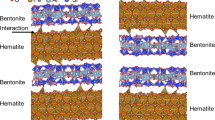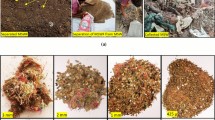Abstract
The waste product phosphogypsum (PG) is produced in phosphoric acid production processes. Its storage requires large amounts of land resources and poses serious environmental risks. In this work, detailed experimental research was carried out to investigate the potential reuse of PG after calcination modification as a novel building material for cast-in-place concrete products. The calcination modification mechanism was studied, and the environmental risk assessment of modified PG was presented. The results showed that the calcination modification includes crystal phase transformation, removal of impurities, and modifying the pH value. The calcination was carried out at 280 °C for 5 h, where the resulting product was a pH value of 7.1, and the soluble fluorine and phosphorus removal rates reached up to 69.2% and 71.2%, respectively. These removal rates met the requirements of the China national standard Phosphogypsum (GB/T 23456-2018). To ensure the environmental safety, ecological risk assessment methods for determining the leaching toxicity of the modified PG were employed. The toxicity of Ba and P elements in the modified PG products was assessed, as well as the leaching toxicity concentrations of all particular heavy metals, which were found well below the limits set by the national standards. All the results presented strongly suggest that the 280 °C modified PG presented here has excellent application potential as a raw component in building materials.




Similar content being viewed by others
Data availability
All data generated or analyzed during this study are included in this published article.
Change history
08 September 2022
A Correction to this paper has been published: https://doi.org/10.1007/s11356-022-22971-4
References
Alam I, Ameen MA, Rehman F (2015) Partial replacement of cement by phosphogypsum in concrete. N Asian Int Res J Sci Eng IT 1(2):1–11
Ankur M, Dibakar R (2020) Utilization of cement rotary kiln waste heat for calcination of phosphogypsum. Therm Sci Eng Prog 20(1):100729
Bianca CM, Antonio GM, Paloma P, Rafael GT (2021) Valorization of phosphogypsum in cement-based materials: limits and potential in eco-efficient construction. J Build Eng 44:102506
Chen QS, Zhang QL, Andy F, Chen X (2017) Utilization of phosphogypsum and phosphate tailings for cemented paste backfill. J Environ Manag 201:19–27
Chen XM, Gao JM, Liu CB, Zhao YS (2018) Effect of neutralization on the setting and hardening characters of hemihydrate phosphogypsum plaster. Constr Build Mater 190:53–64
Contreras M, Teixeira SR, Santos GTA, Gázquez MJ, Romero M, Bolívar JP (2018) Influence of the addition of phosphogypsum on some properties of ceramic tiles. Constr Build Mater 175:588–280
Garg M, Minocha AK, Jain N (2011) Environment hazard mitigation of waste gypsum and chalk: Use in construction materials. Constr Build Mater 25:944–949
Huang Y, Lu J, Chen F, Shui Z (2016) The chloride permeability of persulphated phosphogypsum-slag cement concrete. J Wuhan Univ Technol-Mater Sci Ed 31(5):1031–1037
Jin ZH, Ma BG, Su Y, Qi HH, Lu WD, Zhang T (2021) Preparation of eco-friendly lightweight gypsum: use of betahemihydrate phosphogypsum and expanded polystyrene particles. Constr Build Mater 297(23):123837
Li XB, Zhou ZL, Zhao GY, Liu ZX (2008) Utilization of phosphogypsum for backfilling, way to relieve its environmental impact. Gospod Surowcami Min 24(4):225–232
Liu DS, Wang CQ, Mei XD, Zhang C (2019) An effective treatment method for phosphogypsum. Environ Sci Pollut Res 26:30533–30539
Ma BG, Lu WD, Su Y, Li YB, Gao C, He XY (2018) Synthesis of α-hemihydrate gypsum from cleaner phosphogypsum. J Clean Prod 195:396–405
Mun KJ, Hyoung WK, Lee CW, So SY, Soh YS (2007) Basic properties of non-sintering cement using phosphogypsum and waste lime as activator. Constr Build Mater 21:1342–1350
Nigade S, Bagade M (2015) An experimental investigation of partial replacement of cement by various percentage of phosphogypsum in cement concrete with different water cement ratio. Int J Innov Sci Eng Technol 2(3):347–349
Radwan MM, Heikal M (2005) Hydration characteristics of tricalcium aluminate phase in mixes containing β-hemihydate and phosphogypsum. Cem Concr Res 35:1601–1608
Rashad AM (2015) Potential use of phosphogypsum in alkali-activated fly ash under the effects of elevated temperatures and thermal shock cycles. J Clean Prod 87:717–725
Shen W, Gan G, Dong R, Chen H, Tan Y, Zhou M (2012) Utilization of solidified phosphogypsum as Portland cement retarder. J Mater Cycles Waste Manag 14:228–233
Shen Y, Qian J, Chai J, Fan Y (2014) Calcium sulphoaluminate cements mad with phosphogypsum: production issues and material properties. Cement Concrete Comp 48:67–74
Sheng ZM, Zhou J, Shu Z, Yahaya Y, Chen Y, Wang WB (2018) Calcium sulfate whisker reinforced non-fired ceramic tiles prepared from phosphogypsum. Boletín de la Sociedad Española de Cerámica y Vidrio 57:73–78
Taher MA (2007) Influence of thermally treated phosphogypsum on the properties of Portland slag cement. Resour Conserv Recycl 52:28–38
Tayibi H, Choura ML, Opez FA, Alguacilet FJ, Delgado AL (2009) Environmental impact and management of phosphogypsum. J Environ Manag 90:2377–2386
Wang CQ, Xiong DM (2021) Leaching assessment of aerated concrete made of recycled shale gas drilling cuttings: particular pollutants, physical performance and environmental characterization. J Clean Prod 282:125099
Wang XM, Zhao B, Zhang QL (2009) Cemented backfill technology based on phosphorous gypsum. J Cent S Univ Technol 16(2):285–291
Wang CQ, Liu K, Xiong DM (2022) Property of concrete made of recycled shale gas drilling cuttings. Environ Sci Pollut R 29:2098–2106
Yang L, Zhang YS, Yan Y (2016) Utilization of original phosphogypsum as raw material for the preparation of self-leveling mortar. J Clean Prod 127:204–213
Yassine E, Ilham Z, Hanan El AB, Mohammed B (2020) Characterization and purification of waste phosphogypsum to make it suitable for use in the plaster and the cement industry. Chem Eng Commun 207(3):382–392
Zhou J, Gao H, Shu Z, Wang YX, Yan CJ (2012) Utilization of waste phosphogypsum to prepare non-fired bricks by a novel hydration–recrystallization process. Constr Build Mater 34:114–119
Zhou J, Yu D, Shu Z, Li T, Chen Y, Wang Y (2014) A novel two-step hydration process of preparing cement-free non-fired bricks from waste phosphogypsum. Constr Build Mater 73:222–228
Zhou J, Shu Z, Li TT, Yu DX, Sheng Z, Wang YX (2015) Novel fabrication route for non-fired ceramic tiles only using gypsum. Ceram Int 41(7):9193–9198
Zhou J, Sheng ZM, Li TY, Shu Z, Chen Y, Wang YX (2016) Preparation of hardened tiles from waste phosphogypsum by a new intermittent pressing hydration. Ceram Int 42(6):7237–7245
Funding
The study was financially supported by Opening Project of Key Laboratory of Solid Waste Treatment and Resource Recycle, Ministry of Education (20kfck03), Opening Project of Key Laboratory of Urban Pollutant Conversion, Chinese Academy of Sciences (KLUPC-KF-2020-2), Key Laboratory of Advanced Civil Engineering Materials (Tongji University), Ministry of Education (202103), Youth Project of Science and Technology Research Program of Chongqing Education Commission of China (KJQN202100723).
Author information
Authors and Affiliations
Contributions
Chao-qiang Wang: framework design, experiment, investigation, and analysis. De-ming Xiong: assisting with research and experiments and data analysis. Yu Chen: assisting with research and experiments and data analysis. Kai Wu: assisting with research and experiments and data analysis. Min-jie Tu: assisting with methodology and investigation. Pei-xin Wang: assisting with methodology and investigation. Zhao-ji Zhang: assisting with methodology and investigation. Lei Zhou: assisting with methodology and investigation. All authors read and approved the final manuscript.
Corresponding authors
Ethics declarations
Ethical approval
This study does not contain any studies with human participants and/or animals.
Consent to participate
Written informed consent was obtained from individual participants.
Consent for publication
Not applicable.
Conflict of interest
The authors declare no competing interests.
Additional information
Responsible Editor: Philippe Garrigues
Publisher’s note
Springer Nature remains neutral with regard to jurisdictional claims in published maps and institutional affiliations.
Rights and permissions
Springer Nature or its licensor holds exclusive rights to this article under a publishing agreement with the author(s) or other rightsholder(s); author self-archiving of the accepted manuscript version of this article is solely governed by the terms of such publishing agreement and applicable law.
About this article
Cite this article
Wang, Cq., Xiong, Dm., Chen, Y. et al. Characteristic pollutant purification analysis of modified phosphogypsum comprehensive utilization. Environ Sci Pollut Res 29, 67456–67465 (2022). https://doi.org/10.1007/s11356-022-22737-y
Received:
Accepted:
Published:
Issue Date:
DOI: https://doi.org/10.1007/s11356-022-22737-y




